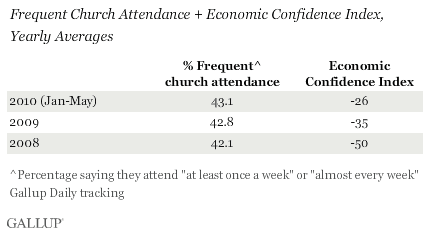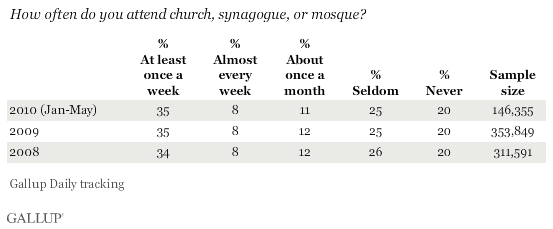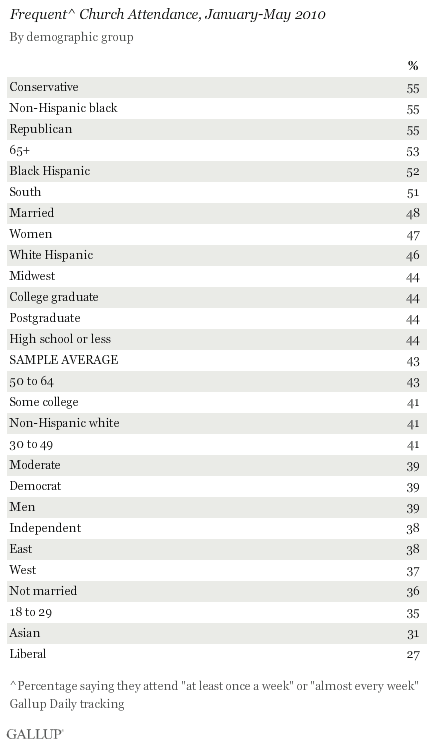PRINCETON, NJ -- Americans' self-reported church attendance has continued to inch up in 2010, with 43.1% of Americans reporting weekly or almost weekly attendance. This is up slightly from 42.8% in 2009 and 42.1% in 2008. The increase comes as Americans' economic confidence has also risen, suggesting that, instead of church attendance rising when economic times get bad, as some theorize, the opposite pattern may be occurring.

Gallup's measure of church attendance is based on more than 800,000 interviews collected as part of Gallup Daily tracking between February 2008 and May 2010. The measure asks respondents to report their church, synagogue, or mosque attendance in one of five categories of frequency. (Detailed month-by-month data are presented on page 2.)

There has been well-publicized speculation about the possibility that church attendance has risen over the past two years as Americans became more despondent and worried as a result of the economic recession. However, trends in Gallup's Economic Confidence Index, an ongoing measure of perceived economic confidence, reflect just the opposite pattern, with both church attendance and economic confidence increasing from 2008 to 2009, and now into 2010.
Such correlations do not prove causality, and it is possible that despite the more positive economic confidence, other economic realities such as unemployment could be related to the increase in church attendance. Still, these particular population-level data do little to directly support the theory that people seek out the solace of religion, as measured in religious service participation, when economic times turn tough.
Church Attendance Among Subgroups
Gallup Daily tracking also documents the extent to which church attendance varies significantly across subgroups of the U.S. adult population.

Major correlates of church attendance include politics (with Republicans and conservatives more likely than others to attend), race (with blacks more likely to attend), age (with older Americans more likely to attend), region (highest in the South), marital status (married adults more likely to attend), and gender (women more likely than men to attend).
Discussion
Church attendance as measured by these self-reports is generally a very stable measure. Still, given the large sample sizes involved in Gallup Daily tracking, the small increase in attendance between 2008 and so far in 2010 is statistically significant, suggesting that there has in fact been an uptick in religious service participation in the real world over the last 2 ½ years. The fact that economic confidence has also increased over this time period confirms previous findings showing little evidence that increased church attendance is a reaction to perceptions of economic woes.
Gallup has also found Americans becoming slightly more conservative in 2009 and so far in 2010. As noted above, conservatives are substantially more likely to attend church than are moderates or, in particular, liberals, suggesting a relationship between this evidence of increasing conservatism and increasing behavioral religiosity.
It is possible that demographics could be affecting church attendance. Gallup analysis documents that Americans in their 60s, 70s, and 80s are significantly more likely to attend church than those who are younger. The oldest of the large group of baby boomers (born between 1946 and 1964) are now entering their 60s. Thus, with each advancing year, more and more baby boomers enter the age range that traditionally has been associated with higher religious service participation. If baby boomers do in fact attend church more frequently as they age, it follows that church attendance would increase steadily in the years ahead.
Results are based on telephone interviews conducted as part of Gallup Daily tracking February 2008-May 2010, with a random sample of a total of 811,895 national adults, aged 18 and older, living in all 50 U.S. states and the District of Columbia, selected using random-digit-dial sampling.
For results based on the total sample of national adults, one can say with 95% confidence that the maximum margin of sampling error is ±1 percentage point.
For results based on the total sample of 311,591 adults interviewed in 2008, one can say with 95% confidence that the maximum margin of sampling error is ±1 percentage point.
For results based on the total sample of 353,849 adults interviewed in 2009, one can say with 95% confidence that the maximum margin of sampling error is ±1 percentage point.
For results based on the total sample of 117,156 adults interviewed January-May 2010, one can say with 95% confidence that the maximum margin of sampling error is ±1 percentage point.
Interviews are conducted with respondents on landline telephones and cellular phones, with interviews conducted in Spanish for respondents who are primarily Spanish-speaking. Each daily sample includes a minimum quota of 150 cell phone respondents and 850 landline respondents, with additional minimum quotas among landline respondents for gender within region. Landline respondents are chosen at random within each household on the basis of which member had the most recent birthday.
Samples are weighted by gender, age, race, Hispanic ethnicity, education, region, adults in the household, cell phone-only status, cell phone-mostly status, and phone lines. Demographic weighting targets are based on the March 2009 Current Population Survey figures for the aged 18 and older non-institutionalized population living in U.S. telephone households. All reported margins of sampling error include the computed design effects for weighting and sample design.
In addition to sampling error, question wording and practical difficulties in conducting surveys can introduce error or bias into the findings of public opinion polls.
For more details on Gallup's polling methodology, visit www.gallup.com/.

